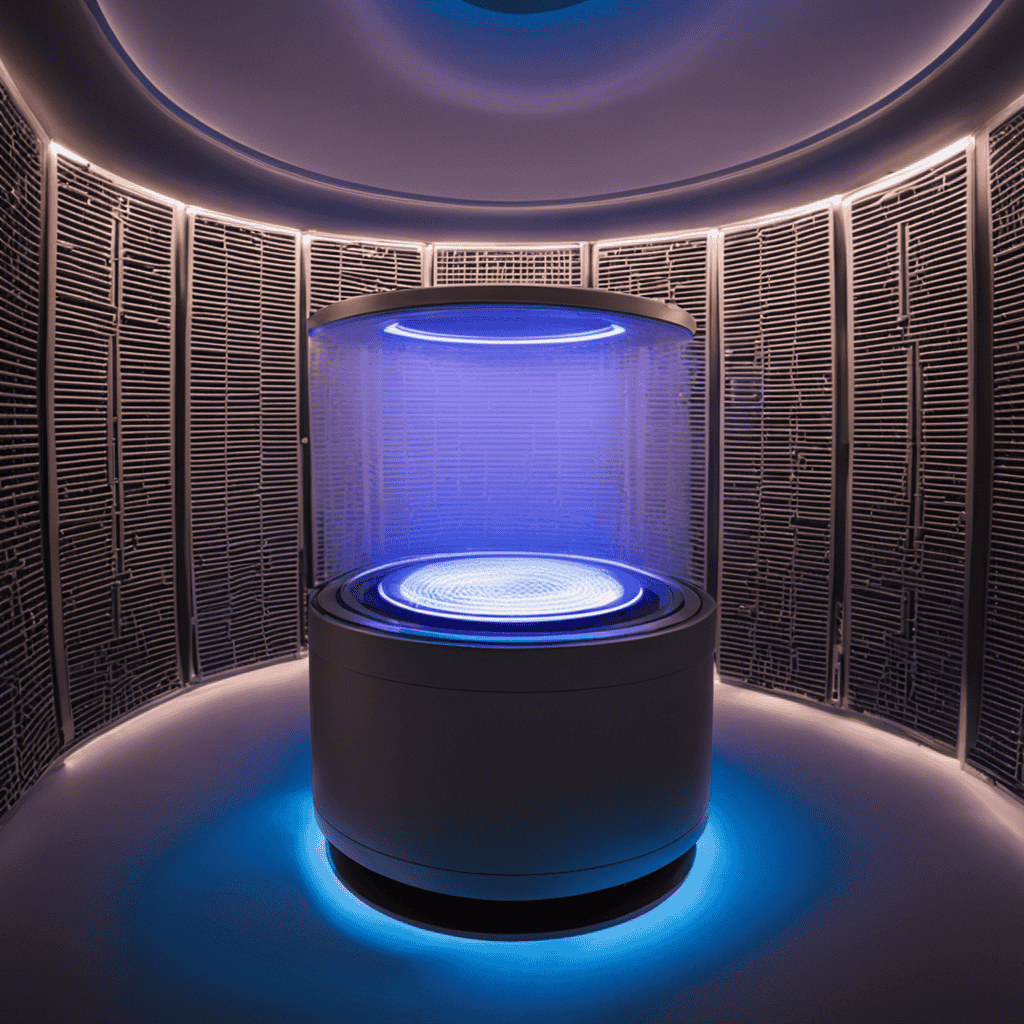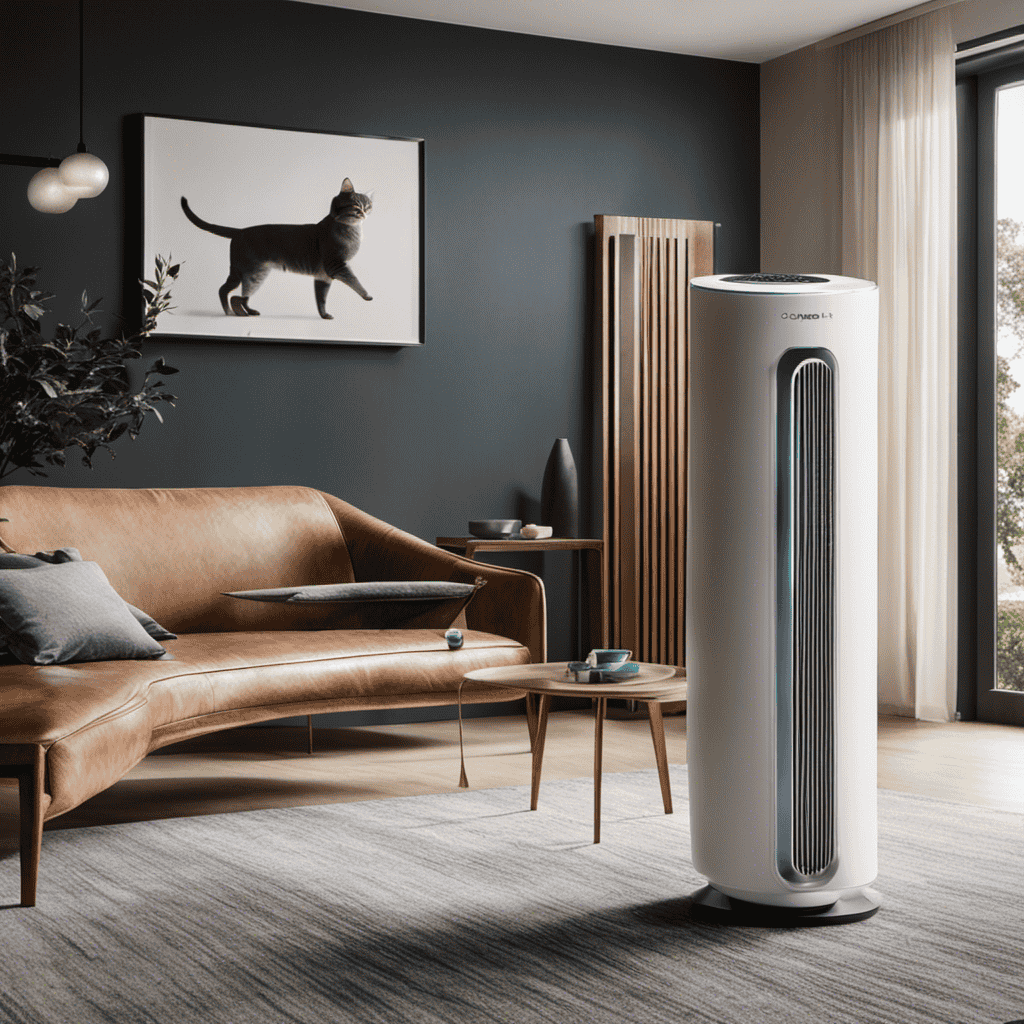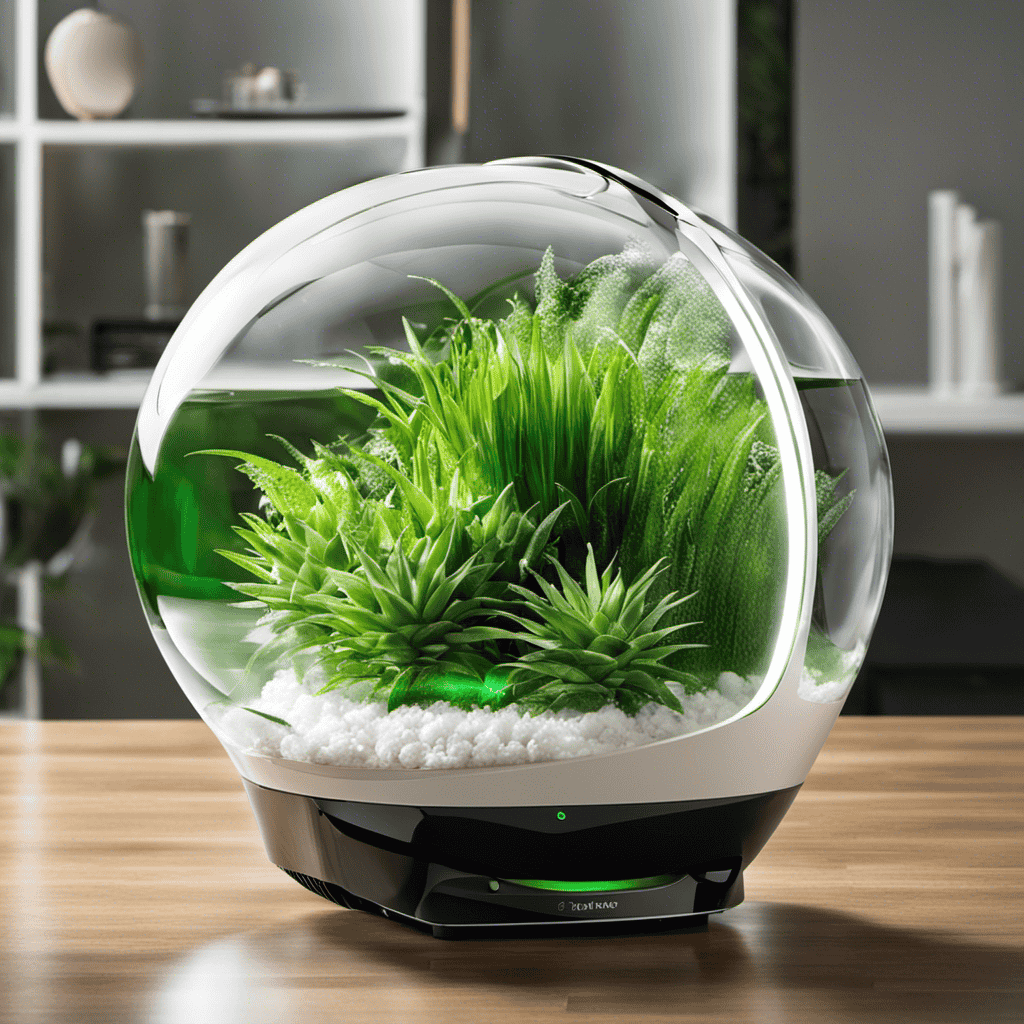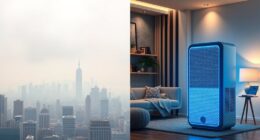As a researcher in air purification technology, I have explored the intriguing realm of UV light and its significance in HEPA air purifiers.
Let me shed some light on the subject.
UV technology, specifically UV-C light, acts as a powerful weapon against airborne contaminants like mold and bacteria. By harnessing the science behind UV-C, HEPA air purifiers enhance their efficiency in eliminating these harmful pathogens.
Join me as we explore the benefits and intricacies of UV technology in HEPA air purification systems.
Key Takeaways
- UV-C light in HEPA air purifiers damages the DNA of airborne contaminants, preventing them from reproducing.
- UV-C light is effective against a wide range of microorganisms, including viruses, bacteria, and mold spores.
- UV-C light does not leave any residue or produce harmful byproducts.
- UV-C light enhances the purification process in HEPA air purifiers and provides an additional layer of protection against harmful pathogens.
How Does UV Light Eliminate Airborne Contaminants
UV light kills airborne contaminants by damaging their DNA, preventing them from reproducing and causing harm. This is where UV-C technology comes into play in air purification.
UV-C light, which is a specific type of ultraviolet light, has been used for decades to sterilize air and surfaces in hospitals, laboratories, and water treatment plants. The benefits of UV-C light in air purification are significant.
It is effective against a wide range of microorganisms, including viruses, bacteria, and mold spores. Unlike chemical disinfectants, UV-C light does not leave any residue or produce harmful byproducts. It is also environmentally friendly and safe for humans when used properly.
The Role of UV Technology in Hepa Air Purifiers
One important aspect to consider in hepa air purifiers is how UV technology plays a role.
UV technology, specifically in the UV-C spectrum, is utilized in air purifiers to effectively eliminate airborne contaminants. UV-C light has a wavelength between 200-280 nanometers, which is capable of destroying the DNA and RNA of microorganisms, rendering them unable to reproduce and causing their demise.
When UV-C light is emitted in the air purifier, it penetrates the cell walls of bacteria, viruses, and mold spores, disrupting their genetic material and preventing their ability to multiply. This technology provides an additional layer of protection against harmful pathogens, enhancing the purification process and ensuring cleaner air.
UV technology in hepa air purifiers works in conjunction with the filter to provide comprehensive air purification, making it an essential feature for those seeking a truly clean and healthy indoor environment.
Understanding the UV-C Spectrum and Its Effects on Airborne Pathogens
To understand how UV technology affects airborne pathogens, it is important to familiarize yourself with the UV-C spectrum and its powerful germicidal effects. UV-C refers to ultraviolet light with a wavelength range of 200 to 280 nanometers. When UV-C light is emitted by a UV air purifier, it penetrates the DNA and RNA of microorganisms, disrupting their genetic material and preventing them from replicating. This effectively kills or inactivates the airborne pathogens, including viruses, bacteria, and mold spores.
The key effects of UV-C on airborne pathogens are:
-
Destruction of DNA and RNA: UV-C light damages the genetic material of microorganisms, making them unable to reproduce and causing their death.
-
Disruption of cellular functions: UV-C light disrupts the cellular processes of pathogens, leading to their inactivation.
Exploring the Benefits of UV-C Light in Hepa Air Purification
When it comes to air purification, one important factor to consider is the effectiveness of UV-C light. UV-C light has been proven to be highly effective in killing airborne pathogens, including bacteria, viruses, and mold.
This makes it an excellent addition to hepa air purifiers, as it helps to further enhance the purification process and improve overall air quality.
UV-C Effectiveness in Purification
The UV-C light in a HEPA air purifier effectively kills germs and bacteria in the air. This powerful form of ultraviolet light is known for its ability to destroy microorganisms by damaging their DNA or RNA, preventing them from reproducing and causing harm. When the air passes through the purifier, the UV-C light targets and neutralizes these harmful pathogens, ensuring cleaner and healthier air for you and your family.
Here are some key points about UV-C safety and applications in air purification:
-
UV-C Safety:
-
UV-C light is harmful to humans and can cause skin and eye damage, so it is important to ensure that the purifier has built-in safety mechanisms to prevent exposure.
-
Proper installation and maintenance of the purifier is crucial to minimize the risk of UV-C exposure.
-
UV-C Applications:
-
UV-C light is commonly used in hospitals, laboratories, and water treatment facilities to disinfect surfaces and sterilize equipment.
-
In air purifiers, UV-C technology complements HEPA filtration by providing an additional layer of protection against airborne pathogens.
Impact on Air Quality
Using UV-C technology in an air purifier can greatly improve the quality of the air you breathe. UV-C light has been proven to be effective in killing bacteria, viruses, and other microorganisms present in the air. This has a direct impact on the health of individuals by reducing the risk of respiratory infections and allergies caused by these harmful pathogens.
UV-C light works by damaging the DNA and RNA of these microorganisms, preventing them from reproducing and causing harm. However, it is important to note that UV-C light can also be harmful to humans if not used properly.
Therefore, it is crucial to ensure UV-C safety by using air purifiers that have built-in safety features such as shields or timers to prevent direct exposure to the light. By incorporating UV-C technology into air purifiers, we can create a healthier and safer environment for everyone.
UV-C Light: An Effective Tool Against Mold and Bacteria in Air Purifiers
When it comes to combating mold and bacteria in air purifiers, UV-C light is an invaluable tool. The powerful ultraviolet rays emitted by UV-C light have been proven to effectively eliminate mold spores and bacteria, helping to improve indoor air quality.
Air purifiers equipped with UV-C light not only provide filtration benefits but also offer an additional layer of protection against harmful microorganisms.
In this discussion, we will explore the benefits of UV-C light in air purifiers and delve into the science behind its effectiveness in eliminating mold and bacteria.
UV-C Vs. Mold/Bacteria
Did you know that UV-C light is effective at killing mold and bacteria in a HEPA air purifier? UV-C light, which falls within the UV-C spectrum, has been proven to be highly effective in eliminating mold and bacteria in air purifiers.
Here are some reasons why UV-C light is so effective:
- UV-C light damages the DNA and RNA of mold and bacteria, preventing them from reproducing and ultimately killing them.
- UV-C light has a germicidal effect, meaning it can destroy the DNA structure of microorganisms, rendering them harmless.
- UV-C light is able to penetrate and disinfect the air, surfaces, and filters within the air purifier, ensuring thorough purification.
Air Purifier Benefits
To get the most out of your air purifier, make sure to regularly clean or replace the filters. Air purifiers offer a range of features and utilize various air purification methods to ensure clean and healthy air in your home or office.
Some common air purifier features include HEPA filters, activated carbon filters, and UV-C light technology. HEPA filters are highly effective at capturing small particles like dust, pollen, and pet dander, while activated carbon filters help to eliminate odors and harmful gases. UV-C light technology, on the other hand, uses ultraviolet light to kill germs, bacteria, and viruses. This is achieved by damaging their DNA and preventing their reproduction.
UV-C light is a powerful tool in the fight against airborne pathogens, making air purifiers with this feature an excellent choice for maintaining a clean and healthy indoor environment. Transitioning into the subsequent section about ‘UV-C effectiveness explained,’ it’s important to understand the science behind how UV-C light works to ensure optimal air purification.
UV-C Effectiveness Explained
Make sure you understand how effective UV-C light is in killing germs and bacteria. UV-C light, with a wavelength between 200 to 280 nanometers, has been proven to be highly effective in destroying the DNA and RNA of microorganisms, rendering them unable to reproduce and causing their ultimate demise.
When it comes to UV-C safety, it is important to note that prolonged exposure to UV-C light can be harmful to human skin and eyes. Therefore, it is essential to follow safety guidelines and precautions when using UV-C devices.
As for UV-C dosage, the intensity and duration of exposure play a crucial role in its effectiveness. Higher levels of UV-C dosage and longer exposure times result in more efficient germ and bacteria eradication.
When using UV-C devices, it is crucial to ensure that the dosage is sufficient to achieve the desired level of disinfection while maintaining safety standards.
-
UV-C Safety:
-
Wear protective gear (such as goggles and gloves) when handling UV-C devices.
-
Keep UV-C devices out of reach of children and pets.
-
UV-C Dosage:
-
Consult the manufacturer’s guidelines for recommended dosage levels.
-
Adjust exposure time and distance to achieve the desired UV-C dosage.
The Science Behind UV-C Technology in Hepa Air Purifiers
Learn about the science behind UV-C technology in HEPA air purifiers and how it effectively eliminates airborne pathogens. UV-C, also known as ultraviolet-C, plays a crucial role in germicidal purification and has a significant impact on indoor air quality. UV-C technology utilizes short-wavelength ultraviolet light to destroy microorganisms like bacteria, viruses, and mold spores. When the air passes through the HEPA filter, it is exposed to UV-C light, which damages the DNA and RNA of these pathogens, rendering them unable to reproduce. This process effectively eliminates the harmful microorganisms from the air, improving the overall air quality. To better understand the science behind UV-C technology, take a look at the table below:
| UV-C Technology | Role | Effectiveness |
|---|---|---|
| Short-wavelength ultraviolet light | Destroys microorganisms | Highly effective |
| Damages DNA and RNA of pathogens | Prevents reproduction | Significantly improves air quality |
| Eliminates bacteria, viruses, and mold spores | Reduces airborne pathogens | Promotes a healthier living environment |
UV-C Light: Enhancing the Efficiency of Hepa Air Purification Systems
Using UV-C light enhances the efficiency of HEPA air purification systems by eliminating harmful pathogens. UV-C light, also known as ultraviolet germicidal irradiation (UVGI), has a wavelength range of 200-280 nanometers, making it effective in destroying microorganisms, including bacteria, viruses, and mold spores.
Here are some key applications and safety precautions associated with UV-C light in HEPA air purifiers:
-
Applications of UV-C Light:
-
Disinfection: UV-C light can effectively kill or inactivate microorganisms, reducing the risk of airborne infections.
-
Odor Control: UV-C light can neutralize odorous compounds, improving indoor air quality.
-
Safety Precautions:
-
Eye and Skin Protection: Direct exposure to UV-C light can be harmful, so it is important to use protective eyewear and avoid direct skin contact.
-
Proper Installation: UV-C lamps should be installed correctly and away from occupied spaces to prevent accidental exposure.
Frequently Asked Questions
Can a Hepa Air Purifier With UV Technology Eliminate All Types of Airborne Contaminants?
Yes, a HEPA air purifier with UV technology can effectively eliminate a wide range of airborne contaminants. UV-C light has been proven to reduce allergens and the use of UV technology has both pros and cons.
How Does UV Light in Hepa Air Purifiers Prevent the Growth of Mold and Bacteria?
UV light in HEPA air purifiers prevents the growth of mold and bacteria by damaging their DNA and stopping their reproduction. It is effective on other air purifiers, but potential side effects include ozone production and eye/skin irritation.
Is UV-C Light Harmful to Humans or Pets When Used in Hepa Air Purifiers?
UV-C light in HEPA air purifiers is not harmful to humans or pets when used as intended. It effectively eliminates airborne contaminants like mold and bacteria, providing a safe and clean environment.
Can the UV-C Light in Hepa Air Purifiers Eliminate Viruses and Other Pathogens?
UV-C light in HEPA air purifiers is highly effective in killing viruses, bacteria, and other pathogens. It plays a crucial role in improving indoor air quality by neutralizing harmful microorganisms and preventing their spread, ensuring a healthier environment.
How Long Does the UV-C Light Bulb in a Hepa Air Purifier Last and Does It Need to Be Replaced Regularly?
The lifespan of the UV-C light bulb in a HEPA air purifier is crucial! Regular replacement is essential to maintain its effectiveness in eliminating pathogens. Don’t neglect this important maintenance task!
Conclusion
In conclusion, the UV technology in HEPA air purifiers acts as a powerful shield against airborne contaminants, symbolizing a beacon of light in the darkness of indoor pollution.
Like a vigilant guardian, the UV-C light eliminates harmful pathogens, mold, and bacteria, ensuring that the air we breathe is clean and pure.
Its scientific prowess enhances the efficiency of HEPA systems, creating a harmonious blend of technology and nature.
With UV-C technology, we can breathe easy, knowing that our air is being purified with the utmost precision and care.










